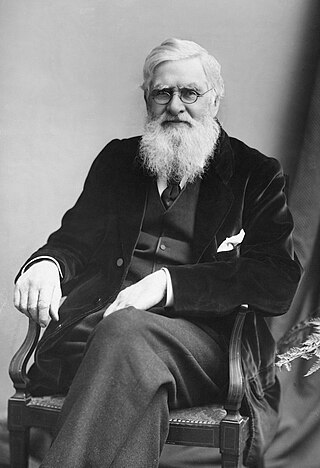
Alfred Russel Wallace was a British naturalist, explorer, geographer, anthropologist, biologist and illustrator. He is best known for independently conceiving the theory of evolution through natural selection. His 1858 paper on the subject was published that year alongside extracts from Charles Darwin's earlier writings on the topic. It spurred Darwin to set aside the "big species book" he was drafting, and quickly write an abstract of it, published in 1859 as On the Origin of Species.
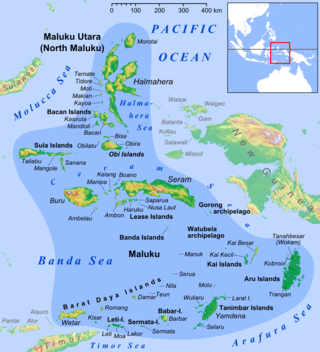
The Maluku Islands or the Moluccas are an archipelago in the east of Indonesia. Tectonically they are located on the Halmahera Plate within the Molucca Sea Collision Zone. Geographically they are located east of Sulawesi, west of New Guinea, and north and east of Timor. Lying within Wallacea, the Maluku Islands have been considered as a geographical and cultural intersection of Asia and Oceania.

The Bacan Islands, formerly also known as the Bachans, Bachians, and Batchians, are a group of islands in the Moluccas in Indonesia. They are mountainous and forested, lying south of Ternate and southwest of Halmahera. The islands are administered by the South Halmahera Regency of North Maluku Province. They formerly constituted the Sultanate of Bacan.

The Malay Archipelago is the archipelago between mainland Indochina and Australia. It has also been called the "Malay world," "Nusantara", "East Indies", Indo-Australian Archipelago, Spices Archipelago and other names over time. The name was taken from the 19th-century European concept of a Malay race, later based on the distribution of Austronesian languages.

Wallacea is a biogeographical designation for a group of mainly Indonesian islands separated by deep-water straits from the Asian and Australian continental shelves. Wallacea includes Sulawesi, the largest island in the group, as well as Lombok, Sumbawa, Flores, Sumba, Timor, Halmahera, Buru, Seram, and many smaller islands. The islands of Wallacea lie between the Sunda Shelf to the west, and the Sahul Shelf including Australia and New Guinea to the south and east. The total land area of Wallacea is 347,000 km2 (134,000 sq mi).
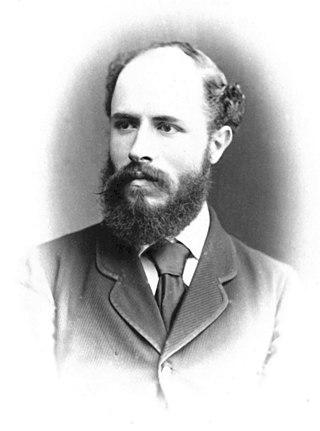
James Wood-Mason was an English zoologist. He was the director of the Indian Museum at Calcutta, after John Anderson. He collected marine animals and lepidoptera, but is best known for his work on two other groups of insects, phasmids and mantises.
Francis Polkinghorne Pascoe was an English entomologist mainly interested in beetles.

Megachile pluto, also known as Wallace's giant bee or raja ofu, is a large resin bee found in Indonesia. With a wingspan of 63.5 mm (2.5 in) it is the largest known living bee species. It was believed to be extinct until several specimens were discovered in 1981. No further sightings were confirmed until two specimens were collected and sold on eBay in 2018. A live female was found and filmed for the first time in 2019.

Darwinism: An Exposition of the Theory of Natural Selection with Some of Its Applications is an 1889 book on evolution by Alfred Russel Wallace, the co-discoverer of evolution by natural selection together with Charles Darwin. This was a book Wallace wrote as a defensive response to the scientific critics of natural selection. Of all Wallace's books, it is cited by scholarly publications the most.

The standardwing bird-of-paradise also known as Wallace's standardwing or as the standardwing is a species of bird-of-paradise. It is the only member in monotypic genus Semioptera.

Ornithoptera croesus, the Wallace's golden birdwing, is a species of birdwing butterfly found in northern Maluku in Indonesia.

The Malay Archipelago is a book by the British naturalist Alfred Russel Wallace which chronicles his scientific exploration, during the eight-year period 1854 to 1862, of the southern portion of the Malay Archipelago including Malaysia, Singapore, the islands of Indonesia, then known as the Dutch East Indies, and the island of New Guinea. It was published in two volumes in 1869, delayed by Wallace's ill health and the work needed to describe the many specimens he brought home. The book went through ten editions in the nineteenth century; it has been reprinted many times since, and has been translated into at least twelve languages.

The common paradise kingfisher, also known as the Galatea paradise kingfisher and the racquet-tailed kingfisher, is a species of bird in the family Alcedinidae. It is found in subtropical or tropical moist lowland forests of the Maluku Islands and New Guinea. Like all paradise kingfishers, it has a red bill and colourful plumage. The species is common and the IUCN has assessed its conservation status as being of "least concern".

The ashy-headed flying fox or North Moluccan flying fox is a species of bat in the family Pteropodidae. It is endemic to Indonesia.

The Sultanate of Bacan was a state in Maluku Islands, present-day Indonesia that arose with the expansion of the spice trade in late medieval times. It mainly consisted of the Bacan Islands but had periodical influence in Ceram and the Papuan Islands. It fell under the colonial influence of Portugal in the 16th century and the Dutch East India Company (VOC) after 1609. Bacan was one of the four kingdoms of Maluku together with Ternate, Tidore and Jailolo, but tended to be overshadowed by Ternate. After the independence of Indonesia in 1949, the governing functions of the sultan were gradually replaced by a modern administrative structure. However, the sultanate has been revived as a cultural entity in present times.
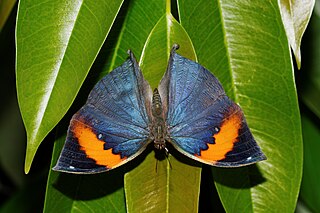
Kallima paralekta, the Indian leafwing or Malayan leafwing, is a species of brush-footed butterfly of the genus Kallima. Despite its common names, it is not found in India or Malaysia, but is endemic to Java and Sumatra of Indonesia. Like other members of its genus, it is remarkable for its strong resemblance to a dead leaf when its wings are folded. It was one of the species encountered by the British naturalist Alfred Russel Wallace in his travels in maritime Southeast Asia. It is mentioned in his famous 19th-century work The Malay Archipelago as one of the best examples of protective camouflage achieved through natural selection.
Bajaw is the language of the Bajaw, widely known as the 'sea gypsies' of Maritime Southeast Asia. Differences exist between the language's varieties in western Sabah, Mapun in southern Philippines, eastern Sabah, and across Sulawesi to Maluku.
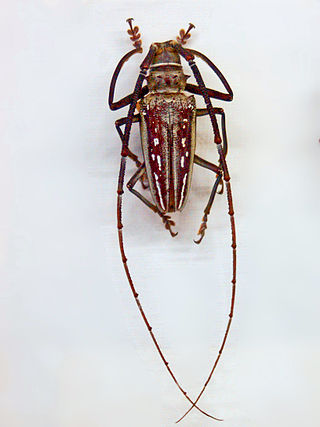
Batocera wallacei, common name Wallace's long-horn beetle, is a species of flat-faced longhorn beetle in the subfamily Lamiinae of the family Cerambycidae. The species name honors Alfred Russel Wallace, who discovered this longhorn beetle on the Aru Islands in Indonesia. It was named after him by James Thomson in 1858.

Kayoa, or in the native language Pulau Urimatiti, is a group of 66 islands, part of the Maluku Islands. It is located in South Halmahera Regency, part of North Maluku Province of Indonesia.

The centenary of the death of the naturalist Alfred Russel Wallace on 7 November 1913 was marked in 2013 with events around the world to celebrate his life and work. The commemorations was co-ordinated by the Natural History Museum, London.
















